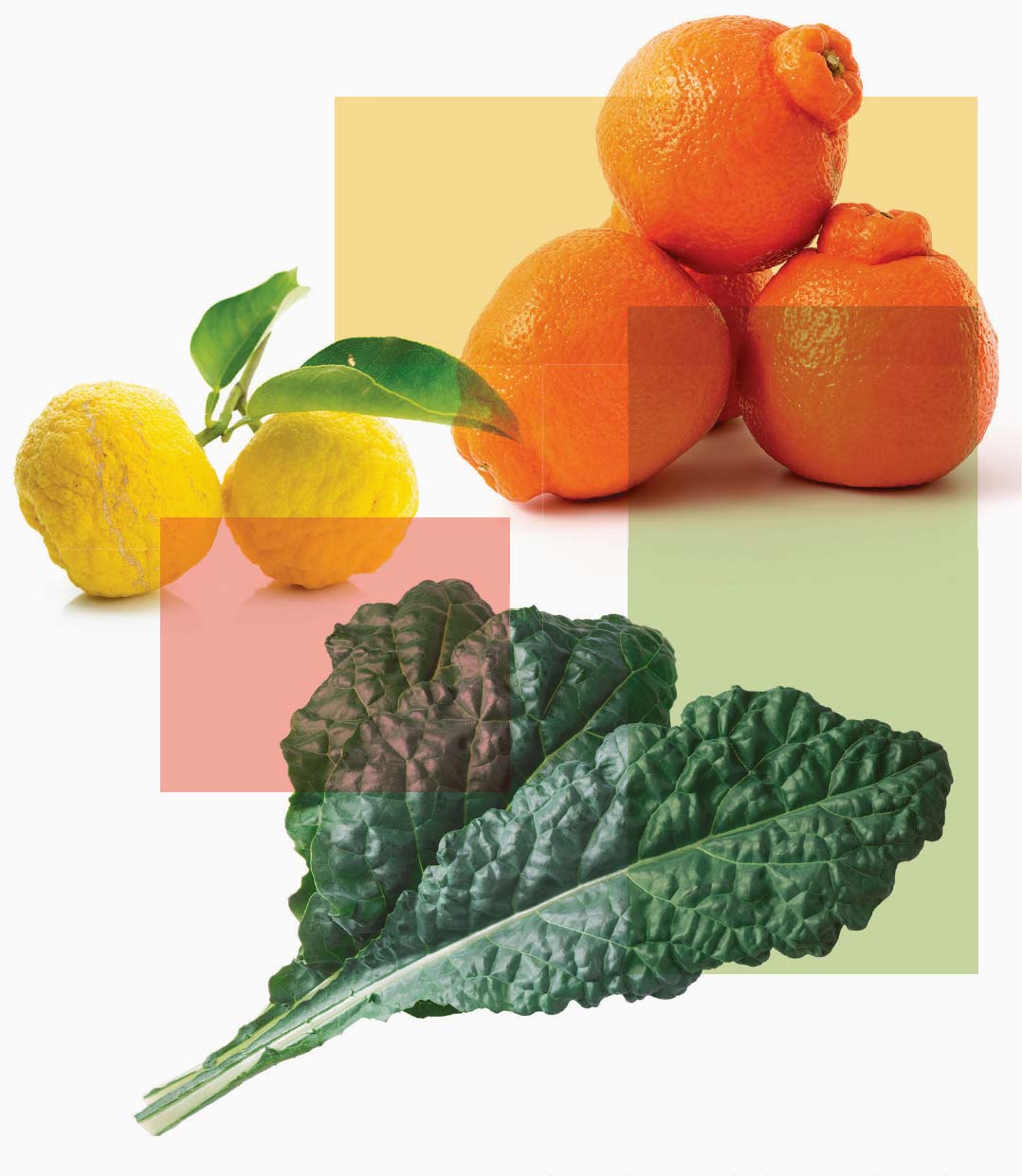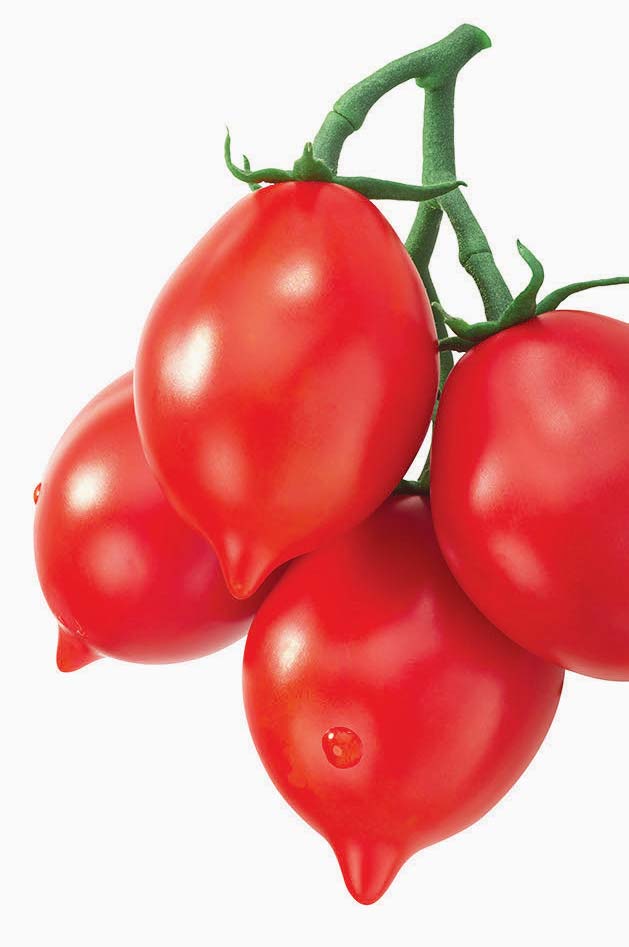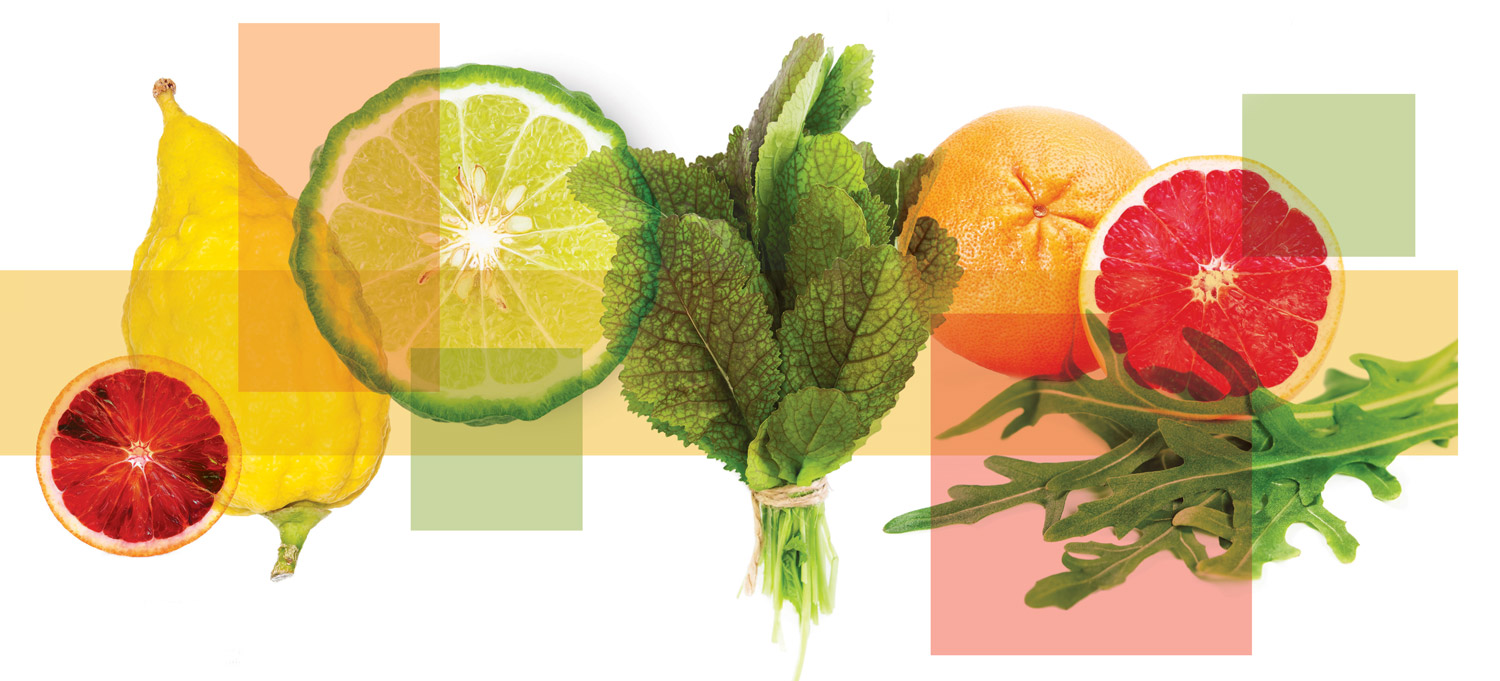A Plethora of Produce
IAN BRENDLE IS GIVING A TOUR OF GREEN MEADOW FARM, walking a small group through a sprawling greenhouse on a winter afternoon. Outside, the air is crisp and the ground is brittle, but inside, a heavy warmth encourages a thick carpet of thriving green herbs.
Brendle, a seventh-generation farmer, stops before a collection of potted fruit trees to offer tiny kumquats up for tasting. The group shares pieces of the sweet skin while Brendle ticks off some of the other citrus he and his family grow in the greenhouse on their farm: Buddha’s hand and blood orange, Meyer lemons, Minneola tangelo and Makrut lime, plus ruby red grapefruit, yuzu and etrog. Most are unfamiliar with that last one, so Brendle explains.
The pale yellow fruit of the etrog has a textured rind, similar to a daikon radish. It’ll grow to the size of a small football, with just a tiny portion of slightly bitter fruit inside, and its thick, dense pith tastes like sweet lemon. You won’t find etrog in the produce aisle at Sprouts, though. The fruit is native to Israel, and Brendle says he’s one of only two farmers in the US growing them. (The other is in California.)
He was prompted to try growing etrog by chef Nick Elmi, who was introduced to the fruit by the team from Coi in San Francisco when they brought it to Philadelphia for a collaboration dinner at Elmi’s restaurant, Laurel. Elmi pickles the etrog’s thinly sliced rind and pith for crudo, or to add some texture to citrus desserts, and he wanted a dependable source for the fruit.
Brendle has become known for stories like this. Chefs turn to him for the ingredients that help fuel their creativity. In the process, he’s promoting biodiversity on his farm. Biodiversity, or biological diversity, is the variation of living things, including all species of plants and animals, humans and bacteria. A 2019 UN report called the current global decline in nature—resulting from, among other things, climate change and pollution—unprecedented. Biodiversity promotes sustainability, so it’s crucial for a thriving, healthy ecosystem.
Located in Gap, Pennsylvania, about 60 miles from Center City, Green Meadow Farm spans 42 acres, with about 6,000 square feet of greenhouses. Brendle’s father, Glenn, came from a long line of farmers and, in the early ‘90s, moved his family—his wife Karen, along with Ian and his sister Anna—into a pre-Revolutionary stone house situated on the stretch of farmland where they now grow everything from microgreens to monster tatsoi. Also living on Green Meadow: a flock of chickens, some pigs and a small herd of Black Angus steer. It’s all part of cultivating a healthy farm that can be the source of remarkable ingredients.
It was Glenn who first started selling his produce and meat to chefs in Philadelphia around 1980, and their biodiversity has multiplied ever since. When COVID-19 hit, the farm shifted to selling CSA-style boxes to keep the farm going. Today, Green Meadow is back to selling directly to chefs, food artisans and restaurants when possible.

Left to right: photos by Jjoja, Womue, Maxsol7 - stock.adobe.com
VIVA VARIETY
As Ian guides the group around this greenhouse, he stops every few feet—in front of a young patch of Korean giant red mustard greens, some arugula—to showcase each. His big, calloused hands cup sprigs of delicate, springy herbs that he offers to each person, followed by tasting notes: bitter, bright, sour, spicy.
It’s clear, as he guides the group from greenhouse to greenhouse, from bright open fields to a dark root cellar, that the young farmer is proud of the incredible bounty they’ve cultivated here, something he estimates is around 300 to 400 different vegetables, fruits and herbs, including upward of 10 varieties of basil and 20 varieties of tomatoes. It’s a dramatically different approach from monoculture or single-crop farming, which dominates across the United States. Roughly half of America’s farmland is planted with just corn, wheat or soy.
Promoting biodiversity is a family tradition on the farm, and the practice has a multitude of benefits.
“I’ve only ever known that style of farming,” Brendle says. “Dad always did it like this. The old saying of ‘don’t put all your eggs in one basket,’ you know, that really rings true in farming.” Cultivating a wide range of crops ensures that if some suffer from bad weather or blight or pests—and it happens often in farming, an industry that faces so many unpredictable variables—they still have plenty of healthy plants to harvest and sell.
“The old saying of ‘don’t put all your eggs in one basket,’ you know, that really rings true in farming.”
What may have started with the senior Brendle’s ethos on biodiversity has flourished under the younger Brendle, driven, in part, by his desire to provide Philly chefs with a dependable pipeline of new and interesting foods. “[At Green Meadow] we understand that Philly chefs want to try new things; they want to be the ones driving what people are eating,” he says. With that in mind, Brendle works hard not only to grow new produce varieties he learns about through his network of farmers, but also to grow almost anything a chef asks him to.
When a chef introduces a diner to a new vegetable, those diners will ask for it at the farmers’ market, creating demand and continuing the cycle of promoting biodiversity. Over the years, the Brendles have grown a wealth of produce, including Tuscan kale before kale was a staple in American kitchens. A chef friend, Stephanie Reitano, had returned from Italy, where she ate a simple dish of cavolo nero kale, slightly warmed and topped with flaked parmesan, salt and pepper. She told Brendle that the dark leafy green would be a big hit if they could grow it.
More recently, the Brendles started growing a new tomato variety for Joe Cicala when he was the chef at Le Virtu. The plump little piennolo grows in the foothills of Mount Vesuvius, near Naples, Italy. “It’s a really luscious, creamy, low-acid tomato— its flavor is unbelievable. Our latitude is pretty much the same. We have similar climates,” notes Brendle. The farm’s tomato harvest will be ready soon, and the piennolos will go in farm share boxes, introducing home cooks to the tiny fruit.
The team’s enthusiasm for growing a diversity of plants helps Philly’s food scene thrive, but it helps Green Meadows Farm thrive, too. As climate change has wreaked havoc the world over, perhaps no one sees its effects more acutely than farmers, and the Brendles are no exception.
They used to plant garlic in late October, and the bulbs would emerge by mid- March. Over the years, they would have to wait for the cold to come, planting later and later, into the first week of December, until one year, even December had pockets of warmer temps. The roots died, and they lost about 80 percent of the garlic. At times like that, it’s essential to have a variety of items to sell.
Biodiversity is also important for its impact on the soil. Different plants leach out certain nutrients, so growing a vast range of crops and rotating the fields where they’re planted each season ensures that the soil stays healthy. But promoting biodiversity also ensures that the farmers aren’t forced to toss most of their crops if the climate doesn’t cooperate in a given year, thus allowing the farm to continue to flourish.
Three years ago, when the region experienced near-constant rain from July to October, certain plants at Green Meadow drowned. “We have clay about a foot down, and the ground was so saturated that the roots were just sitting in water.” But Brendle says they also harvested some amazing produce that season. “I had the biggest leeks that I’ve ever had in my life. I had cippolinis that were six inches in diameter.”
Besides the clear benefit to the soil and the insurance policy it creates, promoting biodiversity is just more enjoyable for the farmers. Choosing new plants by paging through an Italian seed catalog and reading about all the appealing reasons to try Spigarello kale—it’s more nutritious, tender and tasty, according to the catalog—is just more interesting than growing vast plots of the same variety of potato year after year.
“I’m never scared to try growing something once,” Brendle says with confidence. (Though, he says, a lot of the South American stuff is tricky—tubers like mashua and yacón that grow at the foothills of the Andes Mountains.) “Because it’s fun, the challenge. If I were only growing five or ten things per season here, I’d be really bored. I mean, I grow five or ten varieties of just potatoes.” Soon, those potatoes—binchy, French fingerling, Peruvian blue, upstate abundance, russet and more—will be dug up and added fresh to the farm share boxes or sold to chefs, along with heirloom tomatoes and a dozen varieties of beans.
“This is a lifelong education,” Brendle says of Green Meadow, “a never-stop-learning type of gig.”
 THE FARMER & THE CHEFS
THE FARMER & THE CHEFS
Brendle credits these chefs with inspiring his interest in growing the items listed.
Etrog: Nick Elmi of Laurel
Cippolini onion: Marc Vetri
Piennolo: Joe Cicala of Cicala “Joe Cicala also turned me on to nepitella, which is an herb that grows wild around Tuscany and some other regions of Italy.”
Tuscan Kale: Stephanie Reitano, formerly of Capogiro Gelato
White Corn: Cristina Martinez of The People’s Kitchen





